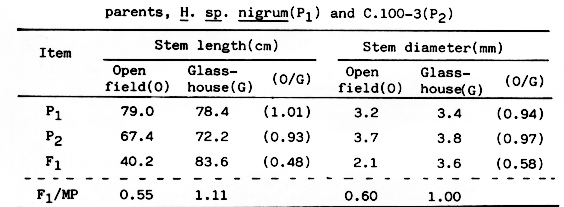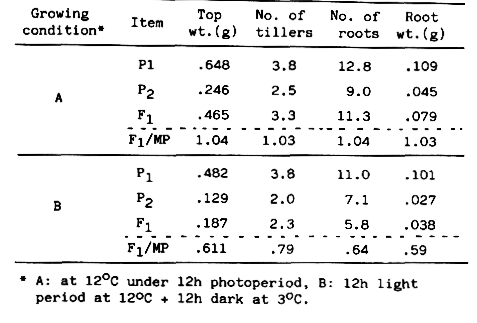

A marked dwarf growth was exhibited by F1 plants from a cross between a strain of H. spontaneum, generally called spontaneum nigrum, and a six-rowed cultivar C.100-3 of North Pakistan origin, when sown in the field in mid-November at Kurashiki (Table 1). However, when they were grown in a glasshouse, the F1 plants were taller than either of the parents (Table 1). The F2 plants derived from these F1's were then sown next autumn for the study of genetics of dwarf growth. The results indicated that at least five plant types, normal, sub-normal, semi-dwarf, dwarf and extreme dwarf, segregated under the open field condition, though a part of extreme dwarf type plants died during cold winter. From the results of F3 test, it was confirmed that segregation of normal type plants and non-normal type ones including four types other than normal one fitted well to 7:9 in F2 (Table 2, Experiment 1). Furthermore, F2 plants were grown in a glasshouse until expanding third leaf of the seedlings and then transplanted on an open field at the end of December (Experiment 2). As seen in Table 2 (Experiment 2), frequency of the non-normal type plants was fewer than that of normal ones, so that segregation of normal and non- normal types did not fit to a ratio 7:9. In order to ascertain the effects of low-temperature on seedling growth, F1 plants of H. sp. nigrum X C.100-3 and their parents were grown under two controlled conditions:(A) at 12°C under 12h photoperiod and (B) 12th light period at 120C + 12h dark at 3°c. Table 3 shows the seedling growth of the F1 parents when they were grown under (A) and (B) conditions for 44 days and 54 days after sowing, respectively. When grown under the low-temperature condition (B), the F1 plants were markedly inferior to their parents in top weight, number of tillers, number of roots and root weight. This was quite different from the results in the condition (A). Furthermore, a total of 166 strains of the H. spontaneum were tested so far, and it was found that two strains other than H. sp. nigrum possessed complementary gene for growth inhibition.


